Calculation of cable cross-section by current, power, length
Today there is a wide range of cable products, with a cross section of conductors from 0.35 mm.kv. and higher.
If you choose the wrong cable cross-section for household wiring, then the result can have two results:
- An overly thick core will “hit” your budget, as her running meter will cost more.
- With an unsuitable conductor diameter (smaller than necessary), the cores will begin to heat up and melt the insulation, which will soon lead to self-ignition wiring and short circuit.
As you know, both of these results are disappointing, therefore, before installation of electrical wiring in the house and the apartment must correctly calculate the cable cross-section depending on the power, current and line length. Now we will consider in detail each of the methods.
Calculation of the power of electrical appliances
For each cable there is a certain amount of current (power) that it is able to withstand during the operation of electrical appliances. If the current (power) consumed by all devices will exceed the permissible value for the conductive core, then soon an accident can not be avoided.
In order to independently calculate the power of electrical appliances in the house, it is necessary to write down the characteristics of each device separately on a piece of paper (stove, TV, lamps, vacuum cleaner, etc.). After that, all values are summed, and the finished number is used to select a cable with conductors with an optimal cross-sectional area.
The calculation formula is:
Ptot = (P1 + P2 + P3 + ... + Pn) * 0.8,
Where: P1..Pn – power of each device, kW
We draw your attention to the fact that the resulting number must be multiplied by a correction factor - 0.8. This coefficient means that of all electrical appliances, only 80% will work simultaneously. Such a calculation is more logical, because, for example, you definitely will not use a vacuum cleaner or a hairdryer for a long time without a break.
Tables for selecting the cable cross section for power:
These are simple and simplified tables; you can find more exact values in PUE p.1.3.10-1.3.11.
As you can see, tabular values have their own data for each particular type of cable. All you need is to find the nearest power value and see the corresponding core section.
In order for you to clearly understand how to correctly calculate the cable by power, we give a simple example:
We calculated that the total power of all electrical appliances in the apartment is 13 kW. This value must be multiplied by a factor of 0.8, which will result in 10.4 kW of actual load. Next, in the table, we look for the appropriate value in the column. We are satisfied with the figure "10.1" for a single-phase network (voltage 220V) and "10.5" if the network is three-phase.
This means that you need to choose a cross-section of cable conductors that will power all the calculating devices - in an apartment, room or some other room. That is, such a calculation must be carried out for each outlet group, powered from one cable, or for each device, if it is powered directly from the shield.In the example above, we gave a calculation of the cross-sectional area of the wires of the input cable for the entire house or apartment.
Total, we select the cross-section on a 6 mm conductor with a single-phase network or 1.5 mm with a three-phase network. As you can see, everything is quite simple and even a novice electrician will cope with such a task on his own!
Calculation of current load
The calculation of the cable cross section for current is more accurate, so it is best to use it. The essence is similar, but only in this case it is necessary to determine the current load on the wiring. To begin with, according to the formulas, we consider the current strength for each of the devices.
If the house has a single-phase network, for the calculation it is necessary to use the following formula:![]() For a three-phase network, the formula will look like:
For a three-phase network, the formula will look like: Where, P - power of the appliance, kW
Where, P - power of the appliance, kW
cos phi power factor
For more information on formulas related to power calculation, see the article:https://my.electricianexp.com/en/kak-najti-moshhnost-toka.html.
Further, all currents are summed up and according to the table values, it is necessary to select the cable cross section for current.
We draw your attention to the fact that the values of the tabular values will depend on the conditions for laying the conductor. At installation of open wiring permissible current loads and power will be much larger than with pipe wiring.
We repeat, any calculation of the cross section is carried out for a particular device or their group.
Cable selection table for current and power:
Length calculation
Well, the last method that allows you to calculate the cable cross-section - along the length. The essence of the following calculations is that each conductor has its own resistance, which, with an increase in the length of the line, contributes to voltage loss (the greater the distance, the greater the loss). In the event that the value of losses exceeds the mark of 5%, it is necessary to choose a conductor with larger conductors.
For calculations, the following methodology is used:
- It is necessary to calculate the total power of electrical appliances and current strength (above we have provided the appropriate formulas).
- The calculation of the resistance of the wiring. The formula is as follows: specific resistance of the conductor (p) * length (in meters). The resulting value must be divided by the selected cable cross-section.
R = (p * L) / S, where p is the tabular value
We draw your attention to the fact that the length of the current passage must be doubled, because current initially flows through one core, and then returns back through another.
- The voltage loss is calculated: the current is multiplied by the calculated resistance.
Uof losses= Iload* Rwires
LOSS = (Uof losses/ Unom)*100%
- The amount of losses is determined: voltage losses are divided by the voltage in the network and are multiplied by 100%.
- The total number is being analyzed. If the value is less than 5%, we leave the selected core section. Otherwise, we select a “thicker” conductor.
Suppose we calculated that the resistance of the wires we have is 0.5 Ohms, and the current is 16 Amps, then:
Uof losses= 16 * 0.5 = 8 Volts
LOSS = (8/220) * 100% = 0.03636 * 100% = 3.6%
Which is perfectly acceptable for most cases, according to GOST 29322-14 “Standard voltages”. More details in the article:https://my.electricianexp.com/en/kakoe-otklonenie-napryazheniya-v-seti-schitaetsya-predelnym.html.
Resistivity table:
If you stretch the line for a fairly long distance, be sure to make a calculation taking into account losses along the length, otherwise there will be a high probability of the wrong choice of cable section.
Video calculation examples
Visual video examples always allow you to better absorb information, so we present them to your attention:
Similar materials:


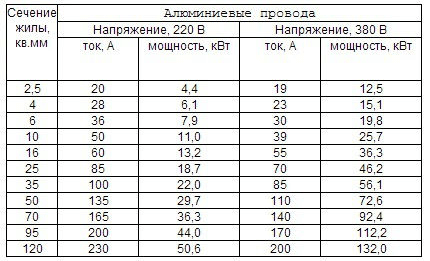
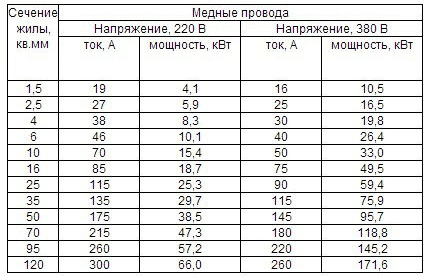
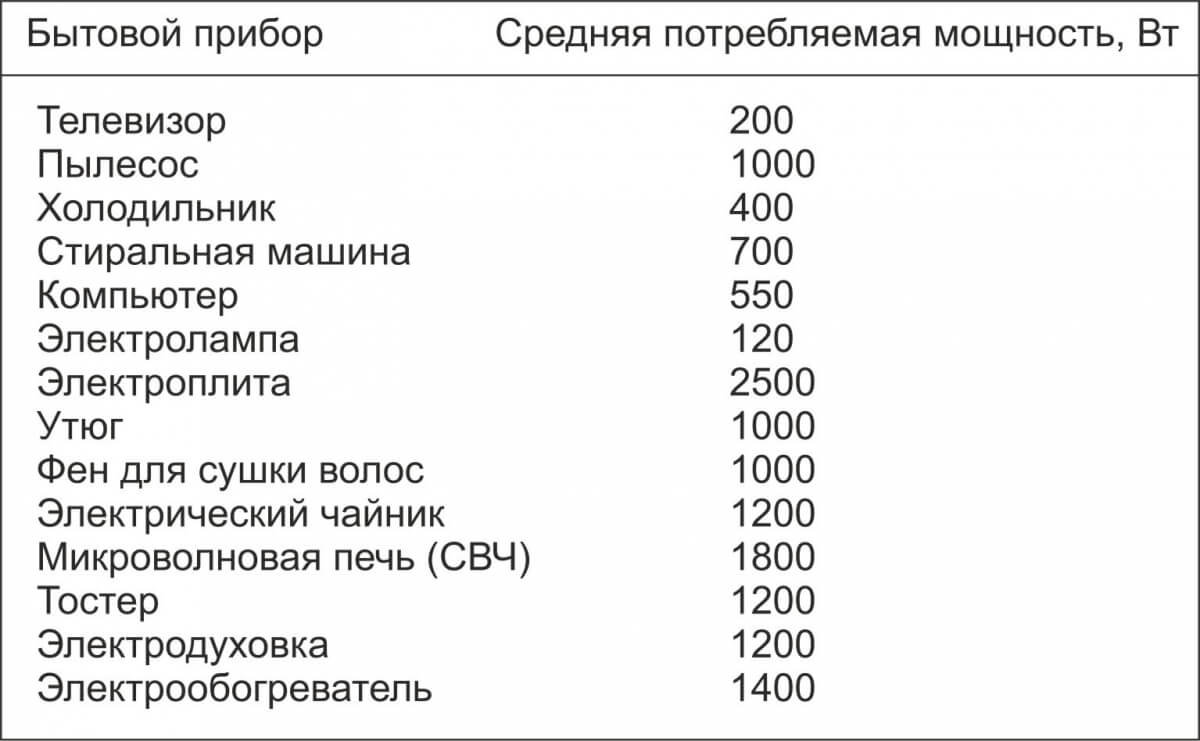

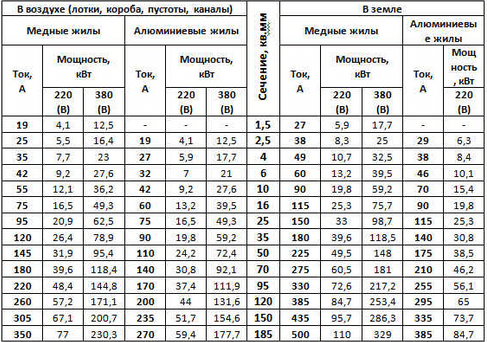



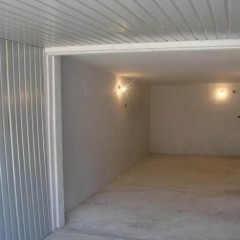
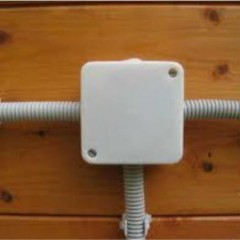
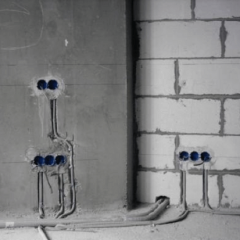

Hello. I want to change the wiring in a one-room apartment. In the apartment it is planned to use only an electrician (without gas) ... I think correctly: to conduct 6-k from the meter to the boxes, to conduct 4-to the sockets, and power the light 1.5. The cable, of course, is copper. But two-core or three-core?
Hello! To begin with - what do you want to connect to outlets? What will be the power of electrical appliances? And yet .. is there grounding in the apartment?
if everything will be electric it is necessary first to distribute it in groups, make the input 10 squares, the outlet group makes 2.5 squares each room with its own machine, light 1.5 squares is more than enough, the oven 4 squares, the hob is the same, the water heater is also four , for all this they don’t put their automatic machines in common boxes, you put the washing machine in an ouzo or differential one of two, and 2.5 squares
how to choose a cable cross section at a distance of 85 meters, with a load of 5 kW for each phase, tell me?
Hello! What voltage and, accordingly, the number of phases in the projected line? I recommend downloading a very useful program - cable, in it you can set all the necessary source data and immediately get the correct answer. Also on the Internet there are many online calculators that allow you to calculate the cross section of the veins. In general, a conductor with at least 4 mm2 of conductors is suitable for such conditions. each one.
Hello. How to find out the cable cross section (aluminum, 3 phases, 150 kW, length 250 meters) ??????
Hello! There is a very good program for the computer - cable v2.1 from Atlas. Download, fill in the data and get the section you need!
Hello! Tell me please, there is a power of 150kV. what cable section (copper) is needed; total cable length is 50 meters.
Good afternoon! Power is measured in kW, and kV is rather a voltage, so the source data are not entirely correct. If nevertheless you meant power, then 150 kW with a cable line length of 50 meters will withstand a cross section of 4 * 25 mm.sq. I recommend downloading the cabel v2.1 program from Atlas. It accurately enough allows you to calculate the cable cross-section by power and length.
The selection table for the cable section for current and power that is in the PUE and above in the article does not coincide with your calculations: copper 25mm.kv with a 380V network holds 150A and 98kW - this is in the ground without taking into account the length of the cable line.
it is necessary to lay underground cable, distance from T.P. 800 m.p. declared power 15kW. 380W which cable is desirable to purchase ???
Hello! Please tell me how to choose a cable (aluminum) with the source data: power 45 kW; the distance from the energy center to the consumer is 1952 meters; network voltage 380 V.
Hello, the wrong section calculation table is on this page. Here https://my.electricianexp.com/en/vybiraem-kabel-dlya-elektroprovodki.html correct.
do not panic if you are not familiar with electricity !!! this is a big responsibility!
Do I need to consider two wire / cable lengths when calculating the losses in a three-phase circuit? There is not always zero, unless the engines are powered.